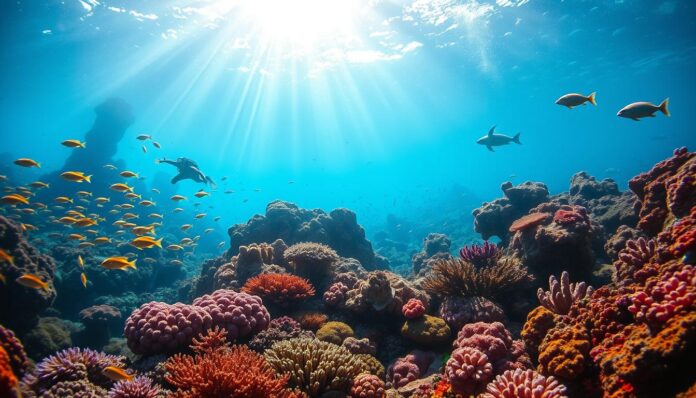| Best Time to Travel | April to November |
| What to Expect | Warm water, clear visibility, diverse marine life |
| Diving Conditions | Year-round, but best from April to November |
| Marine Life | Whale sharks, manta rays, turtles, sharks, dolphins, fish |
Are you ready to explore an underwater paradise? Cape Verde is a hidden gem for scuba diving. It has 10 volcanic islands, each with its own adventures.
Scuba diving in Cape Verde is more than a vacation. It’s a journey to a marine wonderland. You’ll see clear waters and warm tropical seas. These conditions make it perfect for diving.
Every island in Cape Verde has its own unique underwater world. You’ll find volcanic formations and coral gardens. Whether you’re new to diving or have years of experience, you’ll find unforgettable moments here.
Key Takeaways – Scuba Diving in Cape Verde
- Cape Verde features 10 unique volcanic islands for diving
- Underwater visibility ranges up to 30 meters
- Diverse marine life including sea turtles and dolphins
- Warm water conditions similar to Caribbean destinations
- Multiple dive centers across different islands
- Ideal diving conditions from April to October
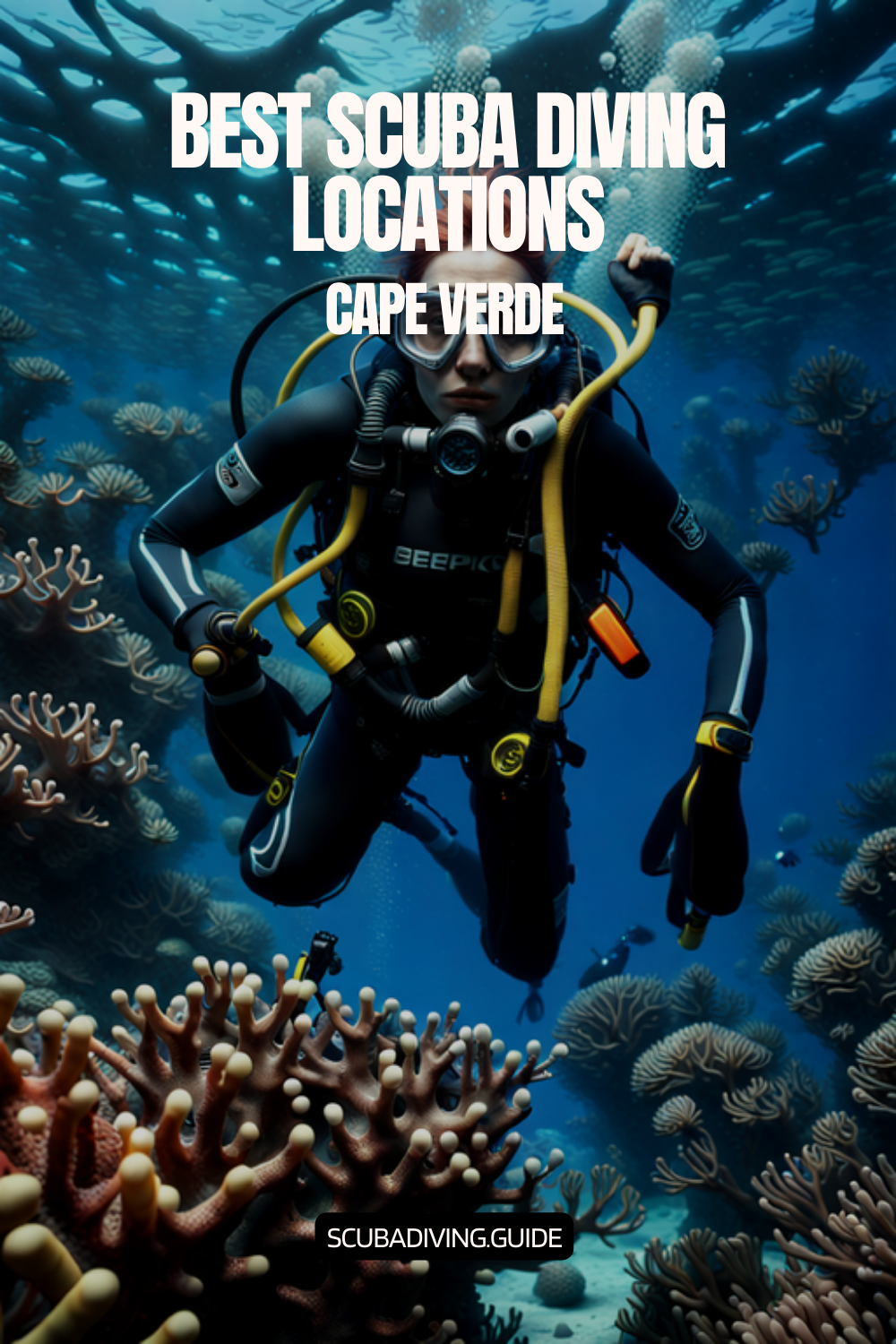
Why Choose Cape Verde for Scuba Diving?
Cape Verde is a top spot for scuba diving, attracting divers from everywhere. It’s in the Atlantic Ocean and has a unique marine world. Here, you can have unforgettable underwater adventures.
Diving in Cape Verde is more than just a hobby. It’s a dive into a world full of life. The area is known for its amazing marine life, unlike anywhere else.
Unique Marine Diversity
Cape Verde’s marine life is truly special. Divers can see:
- Colorful coral reefs with lots of tropical fish
- Sea turtles swimming by
- Dolphins and rays sometimes
- Reef sharks occasionally
“Cape Verde is a hidden gem for underwater explorers, with a marine landscape as good as the world’s best diving spots.”
Year-Round Diving Conditions
The location of Cape Verde means great diving all year. The water is warm, between 22 and 27 degrees Celsius. This makes it perfect for all divers.
| Diving Season | Water Temperature | Marine Life Highlights |
|---|---|---|
| Summer (May-November) | 24-27°C | Peak marine activity |
| Winter (December-April) | 22-24°C | Whale shark migrations |
With 25 diving sites across its islands, Cape Verde is a paradise for those who love the sea. It offers new and exciting underwater experiences.
Best Time to Dive in Cape Verde
Cape Verde is a top spot for diving all year round. Its unique location means divers can explore different marine worlds. This makes it a dream destination for underwater fans.
April to November is the best time for diving in Cape Verde. The water is warm, between 23°C and 25°C. This makes it perfect for diving.
Seasonal Weather Patterns
The weather in Cape Verde changes with the seasons. This affects diving experiences:
- Summer months (August-September): Warmest period with temperatures reaching up to 28°C
- Winter months (December-March): Cooler temperatures and windier sea conditions
- Spring and autumn: Most stable diving conditions
Peak Diving Seasons
Knowing the seasons helps divers plan better:
| Season | Water Temp | Diving Conditions | Marine Life Highlights |
|---|---|---|---|
| April-June | 23-24°C | Excellent visibility | Turtle nesting season |
| July-September | 25°C | Warm waters | Whale migration |
| October-November | 24-25°C | Calm seas | Diverse marine encounters |
Pro tip: While diving is possible year-round, the months between December and March can present challenging sea conditions due to increased wind activity.
“Cape Verde offers a diving experience that combines stunning marine biodiversity with consistently favorable underwater conditions.”
Top Dive Sites in Cape Verde
Cape Verde is a paradise for divers with its diverse underwater spots. The volcanic landscape creates amazing underwater worlds. These attract divers from all over.
There’s a wide range of underwater landscapes to explore. From shallow reefs to deep volcanic formations. The ten main islands offer wreck diving for all skill levels.
Santa Maria and Sal Island Diving
Sal Island is a top diving spot with incredible underwater features. The Buracona site has stunning lava tunnels for diving. Depths range from 12m to over 300m, appealing to all divers.
| Dive Site | Depth Range | Notable Features |
|---|---|---|
| Cavala | 28m – 65m | Deep water exploration |
| Lost Anchor | 16m | Suitable for all divers |
| Champignon | Up to 70m visibility | Crystal clear waters |
Baia das Gatas on São Vicente
São Vicente’s Baia das Gatas is a unique diving spot. It has a protected bay and a rich marine ecosystem. Divers can see a variety of marine life in calm waters.
- Water temperatures range from 22°C to 27°C
- Frequent sightings of sea turtles
- Potential whale shark encounters during migration
The Blue Hole on Fogo Island
Fogo Island’s Blue Hole is a geological wonder for advanced divers. It reaches depths of 31m. Divers can hear humpback whale songs from January to April.
“Cape Verde’s diving sites are like underwater museums of volcanic history and marine biodiversity.” – Marine Exploration Magazine
Cape Verde’s diving spots are less crowded, providing a pristine experience. It’s a hidden gem for those seeking unique marine adventures.
Marine Life You Can Encounter
Cape Verde’s underwater world is a treasure trove for scuba diving fans worldwide. The islands’ volcanic reefs offer a unique setting for underwater exploration. Here, you can find unforgettable marine encounters.
The Atlantic currents around these islands support a rich marine ecosystem. Divers will find remarkable experiences on different islands. Each island has its own special marine landscape.
Vibrant Coral Reefs
Cape Verde’s coral reefs are breathtaking, full of life. The reefs, built on volcanic structures, are home to many marine species. This creates a vibrant and dynamic underwater world.
- Dense coral formations covering volcanic rock structures
- Depth ranges from shallow reef systems to deep underwater walls
- Visibility often exceeding 30 meters
Common Species to Spot
Exploring Cape Verde’s waters, divers will see many marine creatures. The area’s rich biodiversity is a treat for all underwater explorers, whether new or seasoned.
- Pelagic Species: Barracudas, tuna schools
- Shark Varieties: Nurse sharks, blacktip and whitetip sharks
- Reef Inhabitants: Moray eels, octopuses, lobsters
Seasonal Visitors and Migratory Patterns
“Cape Verde’s waters are a living, breathing marine sanctuary that changes with the seasons.”
Spring brings humpback whales to Cape Verde’s waters. Summer is when loggerhead turtles nest. These migrations are great for observing marine life.
Water temperatures between 22 and 28 degrees Celsius are perfect for marine life. This makes Cape Verde a top spot for underwater adventures.
Dive Certification and Training
Aspiring divers can explore Cape Verde’s underwater wonders. The archipelago offers diving education through recognized agencies.
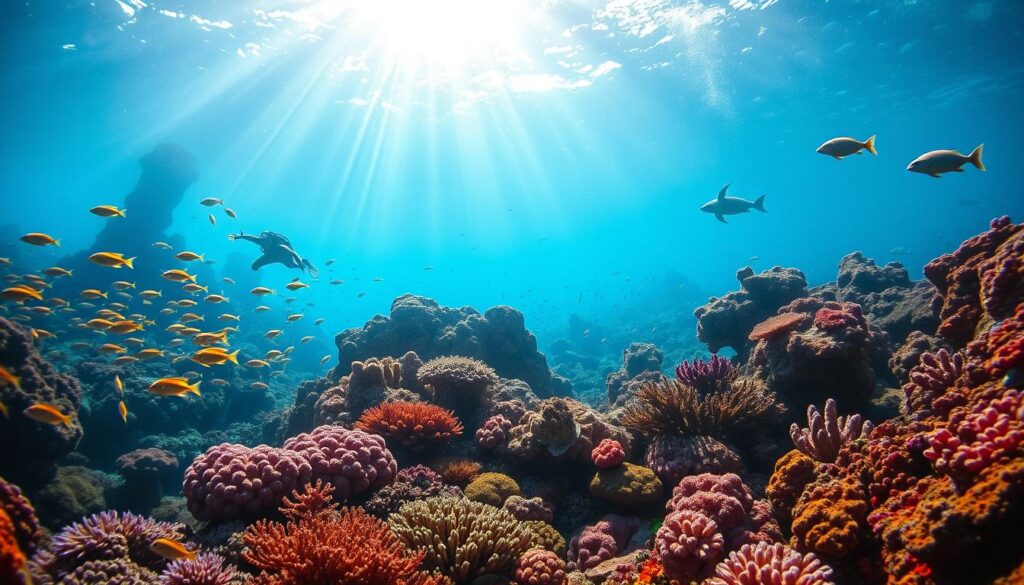
Cape Verde Diving Packages offer flexible learning for all skill levels. Divers can choose from two main certification agencies:
- Professional Association of Diving Instructors (PADI)
- Scuba Schools International (SSI)
Certification Course Options
Training programs meet various diving needs:
| Course Level | Duration | Dives Required |
|---|---|---|
| Try Dive Session | ½ Day | 1 Ocean Dive |
| Scuba Diver Course | 1-2 Days | 2 Ocean Dives |
| Open Water Diver | 3 Days | 4 Ocean Dives |
| Advanced Open Water | 2-3 Days | 5 Adventure Dives |
Training Languages and Accessibility
Dive schools in Cape Verde teach in several languages:
- English
- German
- French
- Portuguese
- Spanish
“Learning to dive in Cape Verde is not just about certification, it’s about experiencing a marine paradise.” – Local Diving Instructor
Refresher courses are available for returning divers. They ensure skill maintenance and safety. Junior divers under 15 follow specific depth and buddy rules for a safe learning environment.
Prices start at 50€, and there are many course options. Cape Verde is a great place for both new and experienced divers to get professional Scuba Certification.
Equipment Rental and Purchase
Getting ready for your dive in Cape Verde needs good planning. Whether you’re an expert or new to diving, knowing where to rent or buy gear is key. It makes your dive better.
Where to Rent Diving Gear
Cape Verde has many places to rent diving gear. ScubaCaribe in Santa Maria is a top choice for diving. They offer great prices and a wide range of rentals:
- Gear rental at €8 per dive
- Multiple dive packages available
- Equipment for all levels, from beginners to certified divers
Selecting Quality Diving Equipment
Choosing the right gear for diving in Cape Verde is important. Look for these things:
- Make sure it fits well and is comfortable
- The gear should be in good condition
- It should be right for the water temperature (66-81°F)
| Dive Package | Price (Approximate) |
|---|---|
| 1 Dive Package | $52 |
| 2 Dive Package | $94 |
| 6 Dive Package | $252 |
| 10 Dive Package | $393 |
“Invest in quality equipment or reliable rental services to ensure a safe and enjoyable diving experience in Cape Verde.”
If you’re not sure about bringing your gear, local dive centers like Riamar Diving Center have you covered. They offer top-notch rentals for all skill levels. This makes exploring Cape Verde’s diving spots easy for travelers.
Pro tip: Book your diving sessions and equipment rental in advance, specially during peak tourist seasons. This ensures you get the best gear and availability.
Safety Tips for Scuba Divers
Diving in Cape Verde is an amazing adventure. But, safety comes first. Knowing the local diving conditions and listening to experienced guides is key to a safe dive.
- Never dive alone – always dive with a buddy or a professional guide
- Get proper dive certification before exploring Cape Verde’s waters
- Have a medical check to make sure you’re fit to dive
- Make sure you have dive travel insurance
Essential Safety Precautions
Certified divers face unique challenges in Cape Verde’s waters. Important safety steps include:
- Always check your gear before diving
- Stick to depth limits (usually 40 meters for fun dives)
- Don’t dive if you’re not feeling well
- Ascend slowly to avoid decompression sickness
Understanding Local Currents
Cape Verde’s seas have strong currents that need careful handling. Local dive guides say it’s important to know the currents and stay alert during your dive.
“Knowing local currents is the difference between a safe dive and a dangerous experience.” – Professional Dive Instructor
By following these tips and respecting the sea, divers can enjoy Cape Verde’s stunning underwater world safely.
Dive Tours and Packages
Cape Verde is a top spot for diving, with its unique marine life. It offers a range of diving packages for all levels. Whether you’re new to diving or have lots of experience, there’s something for you.
Choosing the right dive experience is key. Cape Verde Dive Guides suggest some great options for your underwater adventure:
- Riamar Diving Center: Offers 20 different dive spots on Boa Vista
- Package options ranging from single-day to multi-dive experiences
- Prices starting at $142 for a 3-dive package
Whole-Day Dive Packages
Whole-day dive packages give you a full underwater experience. They usually include:
- Exploring multiple dive sites
- Professional guide services
- Equipment rental
- Lunch and transportation
Guided Tours vs. Independent Diving
There are two main choices: guided tours and independent diving. Guided tours offer a structured experience with expert instructors. Independent diving gives more freedom for those with more experience.
“Cape Verde: Where underwater adventures meet unparalleled marine diversity” – Local Diving Expert
Here are some popular packages:
- 14-dive package at Riamar Diving Center: $503
- PADI Discover Scuba Diving program: $115
- PADI Open Water Diver Course: $464
Choosing the right diving package makes your Cape Verde trip unforgettable. Always check with local dive centers to find the best fit for your skill level and interests.
Eco-Friendly Diving Practices
Cape Verde’s underwater world needs our protection. Divers are key in keeping the marine life safe. They do this by following eco-friendly diving practices.
- Fish stocks have declined by 40% over the last two decades
- Approximately 8 million metric tons of plastic enter oceans annually
- Loggerhead sea turtle populations have dropped by 67% in 20 years
Protecting Marine Life
Responsible diving can help a lot. Here’s how:
- Maintain proper buoyancy control
- Never touch coral reefs or marine creatures
- Avoid disturbing underwater habitats
- Participate in marine conservation activities
Sustainable Diving Organizations
| Organization | Conservation Efforts | Impact |
|---|---|---|
| Project Biodiversity | Sea Turtle Conservation Program | 1,500 local volunteers engaged |
| Santa Luzia Marine Reserve | Ecosystem Protection | 11,000 hectares protected |
| GREEN FINS | Eco-Friendly Diving Practices | Promoting marine conservation |
“Leave nothing but bubbles and take nothing but memories” – A sustainable diving philosophy
Cape Verde’s underwater world is delicate and needs our care. By diving eco-friendly, we protect these amazing places for the future.
Health Considerations for Divers
Scuba diving in Cape Verde needs careful health planning for a safe and fun dive. It’s important to know the local health scene and diving health risks.
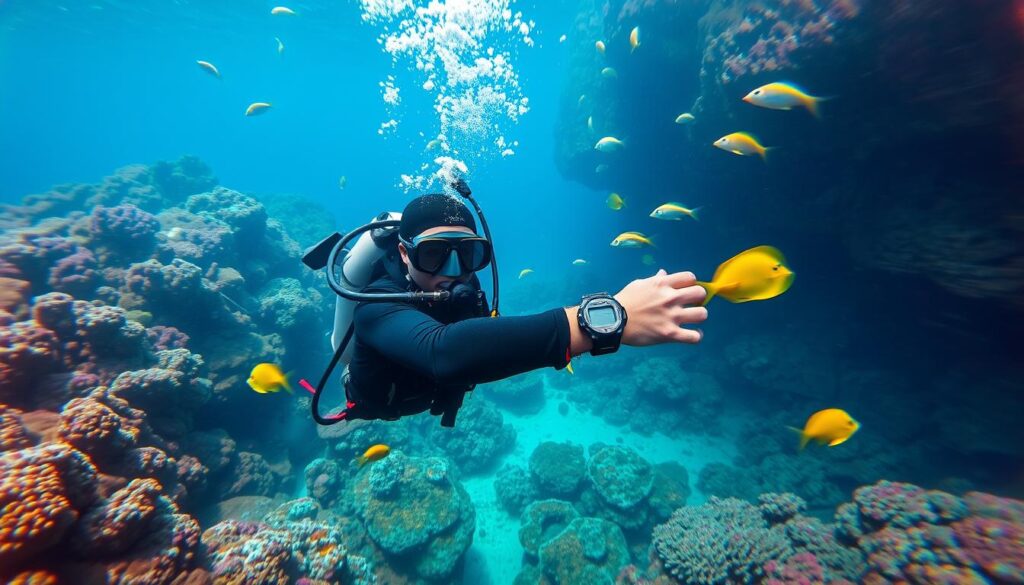
Pre-Diving Medical Screenings
Before diving in Cape Verde, getting a full health check is key. Divers must have a detailed medical exam to make sure they’re fit for diving.
- Complete a detailed medical questionnaire
- Obtain clearance from a certified diving physician
- Disclose any pre-existing medical conditions
- Verify vaccination status
Understanding Decompression Sickness Risks
Diving in Cape Verde comes with special risks for decompression sickness. There’s no hyperbaric chamber, so avoiding it is vital.
| Risk Factor | Recommendation |
|---|---|
| Dive Depth | Stay within 11-45 meters |
| Surface Intervals | Follow strict recommended break times |
| Medical Evacuation | Secure thorough travel insurance |
“Prevention is always better than cure when diving in remote locations like Cape Verde.”
Essential Health Precautions
Scuba diving in Cape Verde means being extra careful about your health. Know the local health issues and take steps to prevent them.
- Get recommended vaccinations
- Carry personal medical kit
- Stay hydrated in warm climate
- Protect against sun exposure
Remember, your health and safety are most important when exploring Cape Verde’s underwater world.
Accommodations Near Dive Sites
Cape Verde has a wide range of places to stay for scuba diving fans. You can find everything from fancy resorts to cozy guesthouses. No matter your budget or what you like, there’s a perfect spot to stay and dive.
Top Hotels for Divers in Santa Maria
Santa Maria is a top spot for divers. It has some of the best places to stay in Cape Verde. Hotels here are designed for those who love to explore the sea.
| Hotel Category | Starting Price | Guest Rating |
|---|---|---|
| 3-Star Hotels | $49 | 9.99/10 |
| 4-Star Hotels | $77 | 8.60/10 |
| 5-Star Resorts | $168 | 8.30/10 |
Budget-Friendly Diving Accommodations
If you’re watching your budget, Cape Verde has great deals. Here are some affordable choices:
- Guesthouses in Santa Maria starting at $32 per night
- Budget 3-star hotels with ratings above 9.0
- Bed & Breakfast options in Sal Rei
“Cape Verde provides a perfect blend of affordable and luxurious accommodations for divers of all budgets.”
Dive-Specific Accommodation Features
When choosing where to stay for diving, look for these features:
- On-site dive centers
- Equipment storage facilities
- Proximity to popular dive sites
- Partnerships with local dive operators
Pro tip: Book places that offer dive packages. It’s a great way to save money and dive more.
Exploring Underwater Photography
Cape Verde Underwater Exploration is a dream for photographers. Its unique volcanic landscapes and rich marine life offer amazing photo opportunities. It’s a chance to capture stunning underwater images.
Starting underwater photography needs skill and the right gear. Beginners can begin their journey with some tips and gear suggestions.
Tips for Capturing Marine Life
- Use natural light during peak visibility hours (April to November)
- Approach marine subjects slowly and respectfully
- Learn to control your buoyancy for steady shots
- Practice patience when waiting for the perfect moment
Recommended Equipment for Beginners
Choosing the right gear is key for underwater photography in Cape Verde’s diverse marine environments.
| Camera Type | Price Range | Best For |
|---|---|---|
| Compact Waterproof Camera | $200-$500 | Beginners, Casual Photographers |
| Mirrorless Camera with Housing | $800-$2000 | Intermediate Photographers |
| Professional DSLR Setup | $3000-$5000 | Advanced Underwater Photographers |
“The magic of underwater photography lies not in expensive equipment, but in understanding your environment and capturing its true essence.” – Professional Marine Photographer
Pro tip: Invest in a good underwater housing to protect your camera and ensure crisp, clear images of Cape Verde’s vibrant marine life.
Local Culture and Attractions
After diving in Cape Verde, you can dive into the local culture. This archipelago is full of life and color. Scuba diving here is not just about the sea. It’s a chance to see a rich and varied culture.
Interacting with Cape Verdean Communities
Getting to know the local culture makes diving better. Portuguese is the main language, but many people speak English too. Here are some tips to connect with locals:
- Learn a few basic Creole phrases
- Respect local customs and traditions
- Show genuine interest in community life
Post-Dive Activities and Cultural Experiences
Cape Verde has lots to do after diving:
- Explore local markets in Santa Maria
- Enjoy live music performances
- Participate in the Carnival festival in February
- Try traditional Creole cuisine
“The true beauty of Cape Verde lies not just in its waters, but in its vibrant culture and warm community spirit.”
The islands offer unique experiences. You can watch traditional dances or visit art galleries. Cape Verde is a mix of African, European, and Creole cultures. It’s a place full of life and color.
Travel Logistics to Cape Verde
Planning your scuba diving trip to Cape Verde is key. The islands offer amazing diving spots through various packages and resorts. Getting there right is essential for a great trip.
Getting to the Islands
Cape Verde can only be reached by air. Four airports are on Sal, Santiago, Boa Vista, and São Vicente. You can fly in from:
- European destinations
- African cities
- North and South American routes
Entry Requirements and Visa Information
Make sure you have these documents ready for your dive:
- Electronic visa (e-visa) costing about €31
- Passport valid for at least six months
- Apply for your visa at least 5 days before you go
Island Transportation Options
Getting around the 10 islands of Cape Verde is easy:
| Transportation Type | Duration | Approximate Cost |
|---|---|---|
| Domestic Flights | 20-30 minutes | Varies by route |
| Ferry Services | 1-6 hours | Budget-friendly |
| Shared Taxis (Aluguer) | Depends on distance | Economical local option |
“Efficient planning transforms a good diving trip into an extraordinary adventure.” – Cape Verde Travel Experts
Tip for divers: Book your diving packages and places to stay early. This is important during busy times like Christmas and summer.
Cape Verde Recommended Scuba Diving Itineraries
When planning a scuba diving trip to Cape Verde, it’s helpful to have a recommended itinerary that allows you to make the most of your diving adventures. Here are a few suggested scuba diving itineraries that showcase the diverse underwater wonders of Cape Verde:
- Sal Island Exploration:
- Day 1: Arrive in Sal Island and settle into your accommodation.
- Days 2-4: Dive the famous dive sites around Sal Island, such as Palmeira Reef, Murdeira Wall, and Ponta Preta. Explore colorful coral formations and encounter an array of marine life, including turtles, moray eels, and reef sharks.
- Day 5: Take a break from diving and explore the vibrant local culture of Sal Island or relax on its beautiful sandy beaches.
- Day 6: Embark on a dive excursion to nearby dive sites, such as Santa Maria Wall or Kite Beach Reef, known for their remarkable underwater landscapes and marine biodiversity.
- Day 7: Enjoy a final dive on Sal Island before departing or take a day trip to nearby islands like Boa Vista for additional diving adventures.
- Island-Hopping Adventure:
- Day 1: Arrive in Santiago and transfer to your accommodation.
- Days 2-4: Dive the dive sites around Santiago, including Tarrafal Wall and Ponta do Atum. Discover fascinating underwater caves, swim with sea turtles, and explore the vibrant marine ecosystems.
- Day 5: Travel to São Vicente and explore its unique dive sites, such as Baía das Gatas and Laginha. Encounter colorful fish species, encounter octopuses, and enjoy the lively atmosphere of Mindelo.
- Days 6-8: Continue your adventure on Santo Antão, diving sites like Baía das Gatas and Monte Trigo. Dive through underwater volcanic formations, encounter groupers, and explore hidden swim-throughs.
- Day 9: Return to Santiago for a final day of diving before departing or take the opportunity to explore the island’s cultural and historical attractions.
- Remote Diving Expedition:
- Day 1: Arrive in Boa Vista and settle into your accommodation.
- Days 2-4: Embark on a liveaboard adventure, exploring remote and less frequented dive sites around Santa Luzia, Brava, and São Nicolau. Dive pristine coral reefs, explore underwater caves, and encounter pelagic species such as sharks, rays, and dolphins.
- Days 5-7: Continue your liveaboard journey, diving around Fogo, Maio, and São Vicente. Experience the unique volcanic underwater landscapes, swim with manta rays, and witness the annual migration of humpback whales.
- Day 8: Return to Boa Vista and enjoy a final day of diving before departing or take the opportunity to relax on its beautiful beaches.
These itineraries are meant to provide a starting point for planning your scuba diving trip to Cape Verde. Depending on your preferences, time availability, and diving experience, you can customize the itinerary to suit your needs. Ensure you consider factors such as dive site accessibility, transportation logistics, and weather conditions when finalizing your itinerary.
By following a recommended scuba diving itinerary, you can explore the diverse underwater landscapes and marine ecosystems that Cape Verde has to offer, creating unforgettable diving memories along the way.
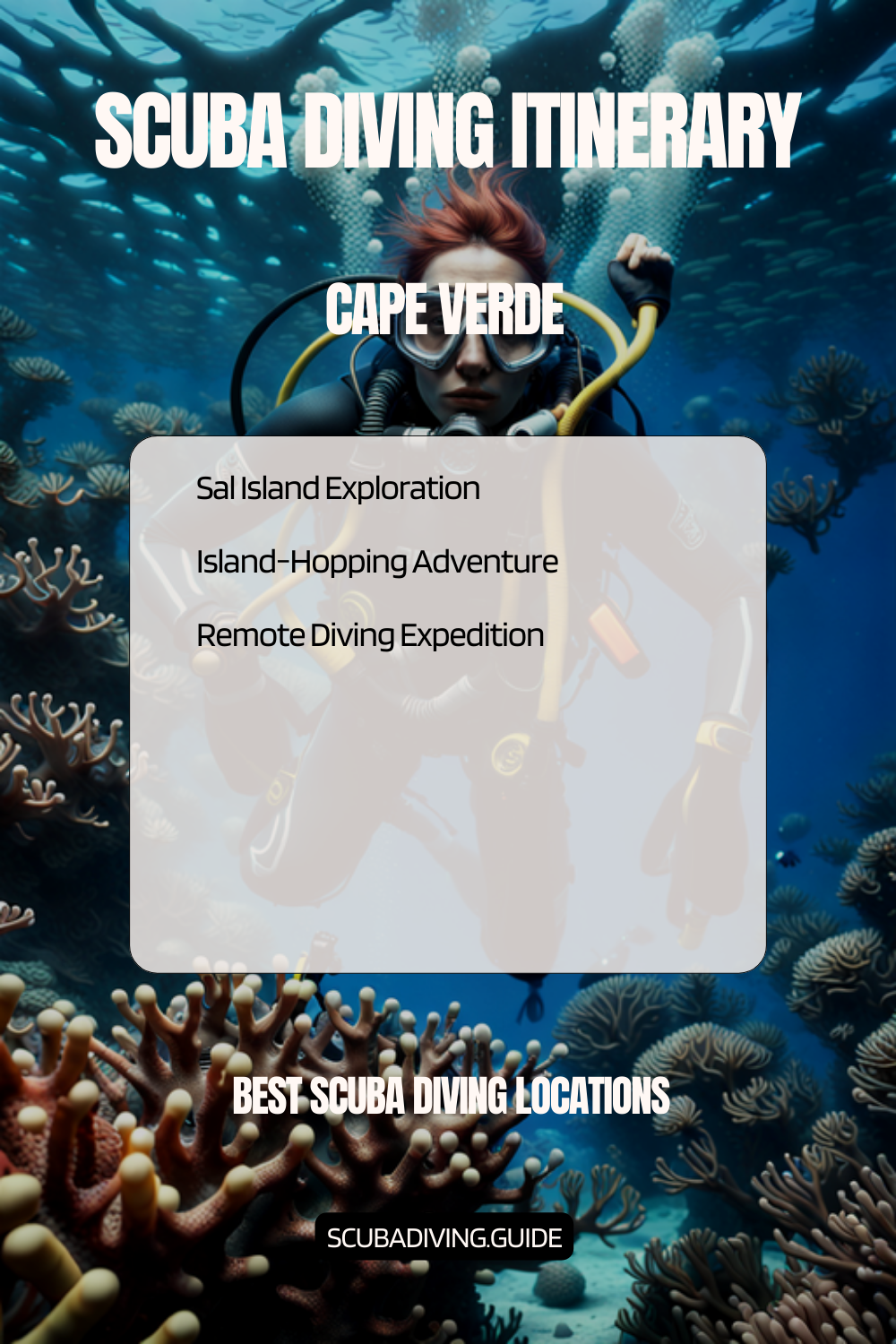
Other Countries to Consider
Conclusion: Dive Into Adventure in Cape Verde
Cape Verde is a top spot for underwater exploration, attracting divers from everywhere. Its waters are home to over 500 fish species, making dives across Sal, São Vicente, and Boa Vista truly special. Each dive here is a unique adventure.
Under the sea, you’ll find dolphins, whales, sharks, and sea turtles. Places like Santa Maria Beach and the Blue Hole on Boa Vista are just the start. The area’s great diving spots and varied marine life make it perfect for all levels of divers.
But there’s more to Cape Verde than just diving. The islands are rich in culture and natural beauty. Local dive centers offer expert advice and unforgettable experiences. Whether you’re into freediving or just want to explore, Cape Verde has it all.
So, get ready for an amazing underwater adventure in Cape Verde. This incredible place offers a journey through some of the most diverse marine environments on Earth. It’s a trip you’ll never forget.
FAQ – Scuba Diving in Cape Verde
What are the best months for scuba diving in Cape Verde?
The best diving months in Cape Verde are May to November. Peak season is June to September. During these months, the water is warm, with temperatures between 73-81°F (23-27°C). This makes for excellent visibility and diving conditions.
You’ll have a great chance to see marine life like humpback whales in spring. Summer is the best time to see nesting sea turtles.
Do I need a specific certification to dive in Cape Verde?
You don’t need a special certification for Cape Verde. But, most dive operators want you to have at least an Open Water Diver certification. This can be from PADI or SSI.
Beginners can take courses on the islands. Advanced divers will find challenging dive sites. Make sure your certification is current and you’re comfortable diving.
What marine life can I expect to see while diving?
Cape Verde’s waters are home to a wide variety of marine life. You’ll see colorful reef fish, moray eels, groupers, and barracudas.
In specific seasons, you might see humpback whales, loggerhead turtles, and sharks like hammerheads and reef sharks. The underwater landscapes are unique, providing homes for many creatures.
Are there any dangerous marine animals in Cape Verde?
Cape Verde’s waters are generally safe. But, divers should watch out for moray eels, lionfish, and sharks. Serious incidents are rare.
Always follow local dive guide instructions. Maintain proper diving practices. Avoid touching or disturbing marine life for a safe and enjoyable dive.
What diving equipment should I bring?
Many dive operators offer equipment rental. But, it’s a good idea to bring your personal mask, snorkel, and dive computer. A 3mm wetsuit is usually enough due to the warm water.
If you prefer using your own gear, make sure it’s well-maintained. Local dive centers can help with any missing equipment.
How much does diving in Cape Verde cost?
Diving costs vary by location and type of dive. A single boat dive costs $50-$80. Package deals can offer better rates.
Certification courses cost between $350-$500. Budget for equipment rental, about $20-$30 per day. Prices might be higher on islands like Sal and Boa Vista.
Is travel insurance important for diving in Cape Verde?
Yes, dive-specific travel insurance is essential. Look for policies that cover diving-related emergencies, evacuations, and equipment loss. Make sure they include hyperbaric chamber treatments and medical repatriation.
Some dive operators may require proof of insurance before diving.
Can beginners dive in Cape Verde?
Cape Verde is great for divers of all levels. There are shallow, calm areas perfect for beginners. Professional instructors are available for introductory courses and guided dives.
Islands like Sal and Boa Vista have beginner-friendly dive sites. They have clear waters and minimal currents.
What are the typical water temperatures in Cape Verde?
Water temperatures in Cape Verde range from 73-81°F (23-27°C) all year. Summer months (June-September) are the warmest, around 79-81°F. A 3mm wetsuit is usually enough for most divers.
Some might prefer a slightly thicker suit for longer dives.
Are there any conservation efforts I can support while diving?
Yes, there are several organizations in Cape Verde focused on marine conservation. The Turtle Foundation and local marine biology groups are examples. Divers can support these efforts by diving responsibly.
Participate in underwater clean-up activities and respect marine habitats. Many dive centers offer eco-friendly diving programs and citizen science projects for environmentally conscious travelers.
